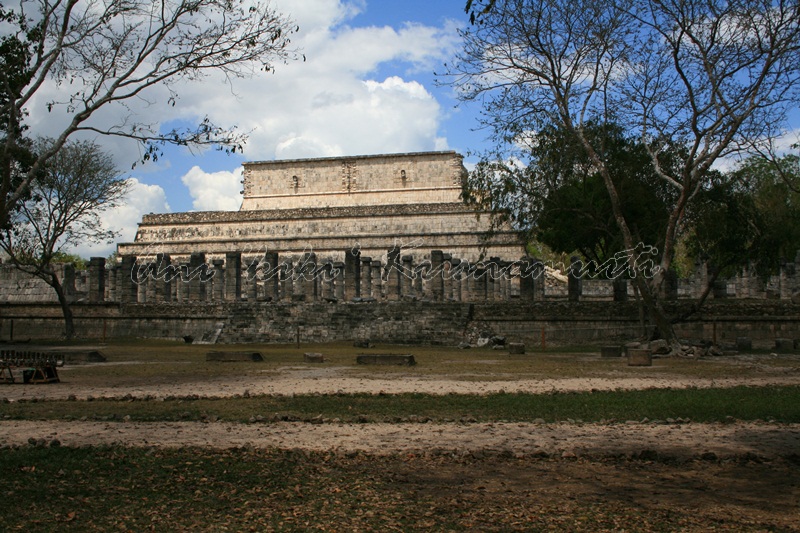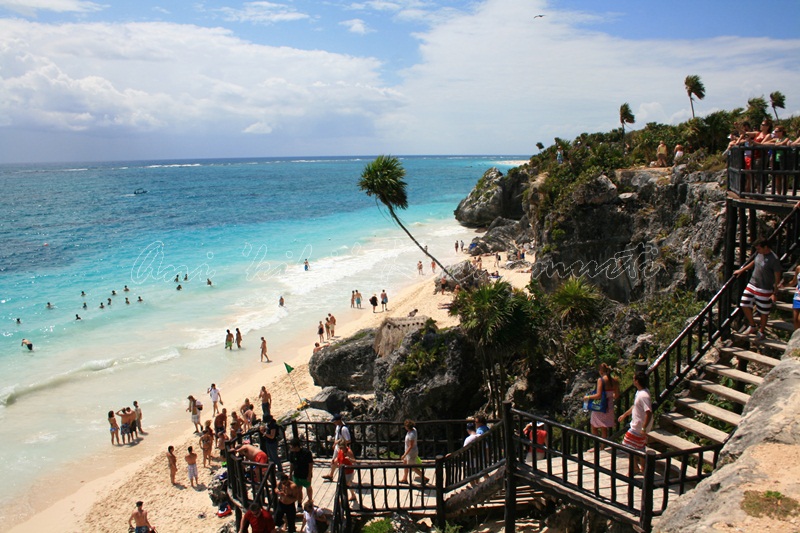


CHICHEN ITZA
Chichen Itza (from Yucatec Maya: Chi’ch’èen Ìitsha’, “at the mouth of the well of the Itza”) was a large pre-Columbian city built by the Maya people of the Post Classic. The archaelogical site is located in the municipality of Tinum, in the Mexican state of Yucatan.

The Maya name “Chichen Itza” means “At the mouth of the well of the Itza. Itzá is the name of an ethnic-lineage group that gained political and economic dominance of the northern peninsula. One possible translation for Itza is “enchanter (or enchantment) of the water”, from its, “sorcerer”, and ha, “water”.
Chichen Itza was a major focal point in the northern Maya lowlands from the Late Classic (c. AD 600–900) through the Terminal Classic (c.AD 800–900) and into the early portion of the Early Postclassic period (c. AD 900–1200). The site exhibits a multitude of architectural styles, reminiscent of styles seen in central Mexico and of the Puuc and Chenes styles of the northern Maya lowlands.

The presence of central Mexican styles was once thought to have been representative of direct migration or even conquest from central Mexico, but most contemporary interpretations view the presence of these non-Maya styles more as the result of cultural diffusion.

Chichen Itza was one of the largest Maya cities and it was likely to have been one of the mythical great cities, or Tollans, referred to in later Mesoamerican literature. The city may have had the most diverse population in the Maya world, a factor that could have contributed to the variety of architectural styles at the site.

Chichen Itza is one of the most visited archaeological sites in Mexico; an estimated 1.2 million tourists visit the ruins every year.
Chichen Itza, a UNESCO World Heritage Site, is the second-most visited of Mexico’s archaeological sites. The archaeological site draws many visitors from the popular tourist resort of Cancún, who make a day trip on tour buses. In 2007, Chichen Itza’s El Castillo was named one of the New Seven Wonders of the World after a worldwide vote

Dominating the North Platform of Chichen Itza is the Temple of Kukulkan, usually referred to as El Castillo (“the castle”). This step pyramid stands about 30 metres (98 ft) high and consists of a series of nine square terraces, each approximately 2.57 metres (8.4 ft) high, with a 6-metre (20 ft) high temple upon the summit.
Chichen Itza was one of the largest Maya cities, with the relatively densely clustered architecture of the site core covering an area of at least 5 square kilometres (1.9 sq mi)
Chichen Itza holds uttermost valuable information of Pre Hispanic past. Due to its beauty and singularity, it is a cultural referent for Mexicans and a symbol of national and indigenous identity. http://www.chichenitza.inah.gob.mx/

The Cenote Sagrado was a place of pilgrimage for ancient Maya people who, according to ethnohistoric sources, would conduct sacrifices during times of drought.
TULUM

Tulum (sometimes Tulum Pueblo) is the largest community in the municipality of Tulum, Quintana Roo, Mexico. It is located on the Caribbean coast of the state, near the site of the archaeological ruins of Tulum.
ruins of Tulum

Tulum is the site of a Pre-Columbian Maya walled city serving as a major port for Coba. The ruins are situated on 12-meter (39 ft) tall cliffs, along the east coast of the Yucatan Peninsula on the Carribean Sea
Tulum was one of the last cities inhabited and built by the Mayas; it was at its height between the 13th and 15th centuries and managed to survive about 70 years after the Spanish began occupying Mexico. Old World diseases brought by the Spanish settlers appear to have been the cause of its demise.

Tulum has architecture typical of Maya sites on the east coast of the Yucatan Peninsula. This architecture is recognized by a step running around the base of the building which sits on a low substructure.

Tulum was protected on one side by steep sea cliffs and on the landward side by a wall that averaged about three to 5 meters (16 ft) in height
 The wall also was about 8 m (26 ft) thick and 400 m (1,300 ft) long on the side parallel to the sea.
The wall also was about 8 m (26 ft) thick and 400 m (1,300 ft) long on the side parallel to the sea.
The Dos Ojos Cenotes
The Dos Ojos Cenotes are a popular snorkeling and cavern diving site receiving typically a hundred or more tourists per day
Dos Ojos (from Spanish meaning “Two Eyes”; officially Sistema Dos Ojos) is a flooded cave system located north of Tulum
The exploration of Dos Ojos began in 1987 and still continues. The surveyed extent of the cave system is 82 kilometers (51 mi) and there are 28 known sinkhole entrances, which are locally called cenotes.
text taken from wikipedia
pictures are properties of ani krisnamurti















